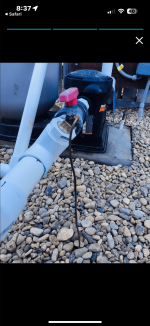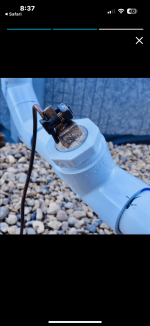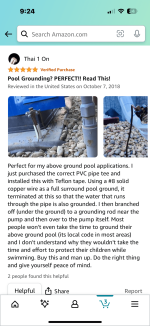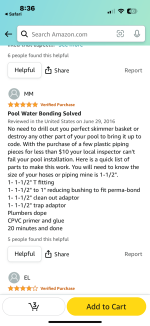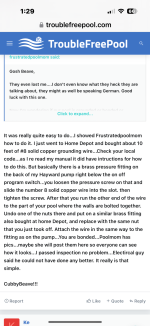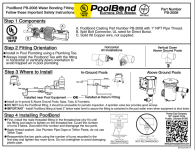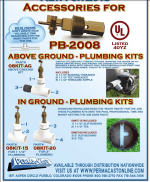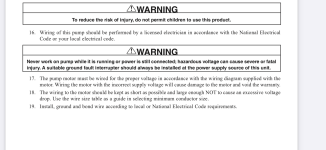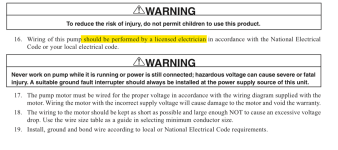Is what this gentleman did ok? I know they make these but wasn't sure the legality of themBonding is for different potentials, which do not necessary have to come from energized equipment
You should have the following:
A copper ring around your pool, buried 4-6" in the ground. That ring should be tied into the metal uprights at 4 equal points around the pool. Technically you are not supposed to use self tapping screws to attach the lugs to the uprights, as they do not make enough contact. You are supposed to use a nut and bolt. I'm not sure how you do that after the fact. I attached my lugs with stainless steel bolts and nuts before installing the uprights.
Anyway, the copper gets buried around the pool, and attached at 4 points. You also need to connect the bonding lugs on any electrical equipment (pumps, SWCG, etc) to this ring. You also need to bond the water to this ring. You can bond the water in a variety of ways - via a plate in the skimmer, through a section of metal piping, or sometimes via a heater. You also need to bond anything metal that is within 6' of the waters edge. A ladder, a diving board, a gazebo, etc. It all gets connected together.
You do not want to bond to plastic on your uprights, you want to bond to the metal. My uprights have plastic "shoes" as well. You could slide the shoe up, attach to the metal underneath, and slide the shoe back down, or you can do what I did and just bond into the leg above the shoe.
Bonding and grounding
- Thread starter Tnt17tnt
- Start date
You are using an out of date browser. It may not display this or other websites correctly.
You should upgrade or use an alternative browser.
You should upgrade or use an alternative browser.
- Jul 21, 2013
- 52,817
- Pool Size
- 35000
- Surface
- Plaster
- Chlorine
- Salt Water Generator
- SWG Type
- Pentair Intellichlor IC-60
Is what this gentleman did ok? I know they make these but wasn't sure the legality of them
That setup satisfies the requirement for a water bond. The water needs to be bonded as well as the pool structure, deck, and equipment.
NEC 680.26(B) lists all the things that must be bonded together...
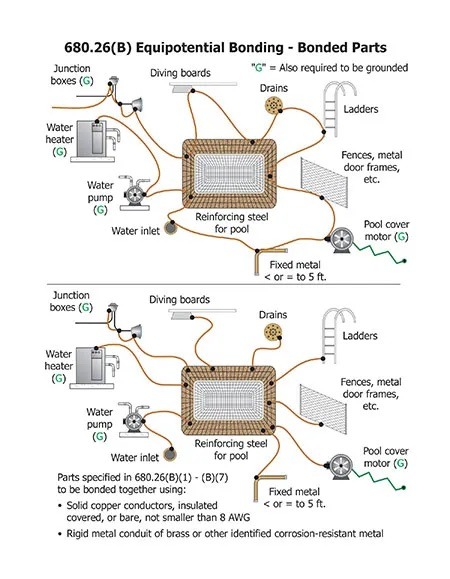
That Amazon writeup confuses bonding with grounding and talks about connecting to a ground rod which is all wrong.
I saw that and wondered what he was doing. Mainly just the water part with perma cast bonding fitting and how it was done compared the skimmer plate and drilling though it.That setup satisfies the requirement for a water bond. The water needs to be bonded as well as the pool structure, deck, and equipment.
NEC 680.26(B) lists all the things that must be bonded together...

That Amazon writeup confuses bonding with grounding and talks about connecting to a ground rod which is all wrong.
How does the deck play in? Or why.That setup satisfies the requirement for a water bond. The water needs to be bonded as well as the pool structure, deck, and equipment.
NEC 680.26(B) lists all the things that must be bonded together...

That Amazon writeup confuses bonding with grounding and talks about connecting to a ground rod which is all wrong.
- Jul 21, 2013
- 52,817
- Pool Size
- 35000
- Surface
- Plaster
- Chlorine
- Salt Water Generator
- SWG Type
- Pentair Intellichlor IC-60
How does the deck play in? Or why.
I have no idea what you are asking.
Bonding of perimeter areas of the pool was discussed int he video you linked to.
" The water needs to be bonded as well as the pool structure, deck, and equipment."I have no idea what you are asking.
Bonding of perimeter areas of the pool was discussed int he video you linked to.
I must had missed the deck then. Decks have screws but unless there are steel steps or rails they are typically wooden.
- Jul 21, 2013
- 52,817
- Pool Size
- 35000
- Surface
- Plaster
- Chlorine
- Salt Water Generator
- SWG Type
- Pentair Intellichlor IC-60
Decks can be many different materials - concrete, pavers, bricks, dirt, wood." The water needs to be bonded as well as the pool structure, deck, and equipment."
I must had missed the deck then. Decks have screws but unless there are steel steps or rails they are typically wooden.
Does not matter what type of deck, the ground around the perimeter of the pool needs to have a bonding grid .
phonedave
Well-known member
- May 30, 2012
- 1,962
- Pool Size
- 17000
- Surface
- Vinyl
- Chlorine
- Salt Water Generator
- SWG Type
- Hayward Turbo Cell (T-CELL-5)
Is what this gentleman did ok? I know they make these but wasn't sure the legality of them
Aside from the fact that there is a ground rod in that picture, which is a big no.
The code for bonding water is as follows
680.26(C) Pool Water. Where none of the bonded parts is in direct connection with the pool water, the pool water shall be in direct contact with an approved corrosion-resistant conductive surface that exposes not less than 5800 mm2 (9 in.2) of surface area to the pool water at all times. The conductive surface shall be located where it is not exposed to physical damage or dislodgement during usual pool activities, and it shall be bonded in accordance with 680.26(B).
Usually when you see one of those T fittings used for bonding, they are coated on the inside with copper, making it 9 square inches+ of contact. I'm not sure if that is what he did in the picture.
Lets break down this code
It needs to be an approved corrosion-resistant conductive surface - in my opinion, this is vague. Approved by WHOM,
Not less that 9 square inches of surface area to the pool water - this is pretty straightforward
at all times - This can be an issue if you have a waterbug in a skimmer installed too high, or a T in a high point of the pipe run where you could potentially get a bubble
The rest is pretty clear, you cant just hang a plate on a wire into the pool, as it could easily be removed.
Typically, this means a "Listed" device that has been tested by a NRTL to conform to the standard for that device.It needs to be an approved corrosion-resistant conductive surface - in my opinion, this is vague. Approved by WHOM,
For example, a light has to be listed by a NRTL to the Standard UL676.
As an OSHA Nationally Recognized Testing Laboratory (NRTL) in the U.S., Intertek is also an acceptable certification.
Any underwater light, transformer or piece of equipment should be listed and certified to the UL 676 standard by a Nationally Recognized Testing Laboratory.
ETL Listed Mark
https://www.osha.gov/nationally-recognized-testing-laboratory-program/current-list-of-nrtls
UL Listing required?
When replacing a light fixture that is in a wet niche, is the new fixture required to be UL Listed? I'm considering a fixture from sunseeker, but it is not UL. I would really like to go with the SS fixture, but don't want to do something wrong.
Article 100 of NFPA 70®, National Electrical Code® (NEC®), defines listing as “equipment, materials, or services included in a list published by an organization that is acceptable to the authority having jurisdiction and concerned with evaluation of products or services, that maintains periodic inspection of production of listed equipment or materials or periodic evaluation of services, and whose listing states that either the equipment, material, or service meets appropriate designated standards or has been tested and found suitable for a specified purpose.”

NFPA Journal, NFPA 70, Spring 2021 | NFPA
Understanding the what, when, and why about NEC listing requirementswww.nfpa.org
The requirement is that the light be “Listed”, but not necessarily “UL Listed”.
Listed means certified for use in pools or spas by a qualified testing laboratory.
The accepted standard is UL676.
So, any qualified testing laboratory should make sure that the lights at least meet that standard.
So, it’s a bit confusing since the standard is a UL created standard but the test can be carried out by any “qualified” testing laboratory.
If the light is sold for pool or spa use, it should be listed by a qualified testing laboratory and the manufacturer should specify which testing laboratory has certified the light.
Attachments
E317041 for PERMA-CAST CO | UL Solutions
Search for WDUT on Product iQ | UL Solutions

Swimming Pool and Spa Equipment, Miscellaneous
E322490 for J M PRODUCTS INC | UL Solutions
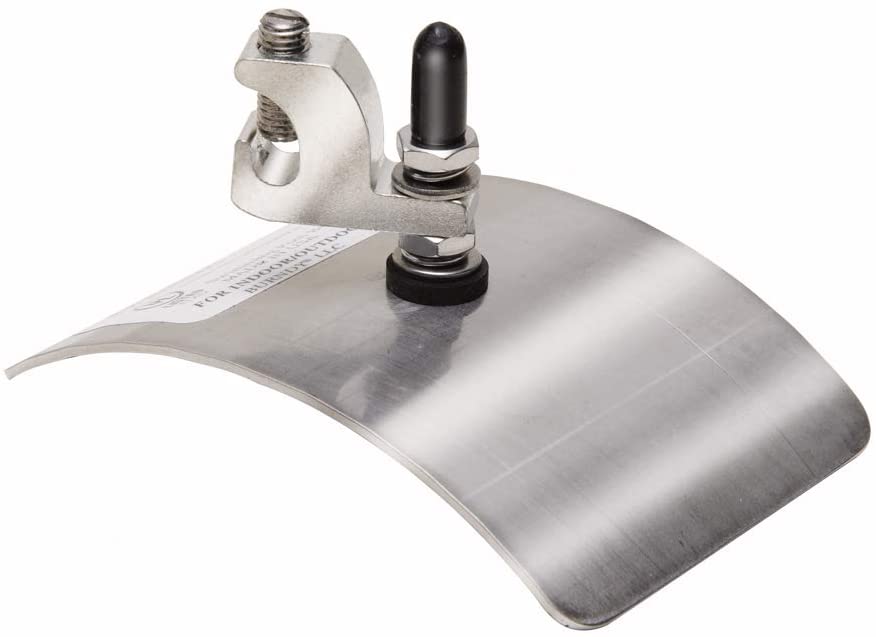
BOND SAFE In Ground Water Bond BS680IG
INGROUND POOL Model #: BS680IG BOND SAFE 680 (Patent Pending and UL Listed) IMPORTANT SAFETY INSTRUCTIONS The integrity of the bonding connection should be periodically inspected.
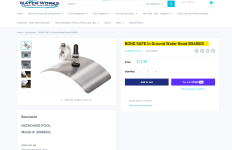

Article 100 of NFPA 70®, National Electrical Code® (NEC®), defines listing as “equipment, materials, or services included in a list published by an organization that is acceptable to the authority having jurisdiction and concerned with evaluation of products or services, that maintains periodic inspection of production of listed equipment or materials or periodic evaluation of services, and whose listing states that either the equipment, material, or service meets appropriate designated standards or has been tested and found suitable for a specified purpose.”Approved by WHOM,
Approved. Acceptable to the authority having jurisdiction.
Listed.
Equipment, materials, or services included in a list published by an organization that is acceptable to the authority having jurisdiction and concerned with evaluation of products or services, that maintains periodic inspection of production of listed equipment or materials or periodic evaluation of services, and whose listing states that either the equipment, material, or service meets appropriate designated standards or has been tested and found suitable for a specified purpose.
Informational Note: The means for identifying listed equipment may vary for each organization concerned with product evaluation, some of which do not recognize equipment as listed unless it is also labeled.
Use of the system employed by the listing organization allows the authority having jurisdiction to identify a listed product.
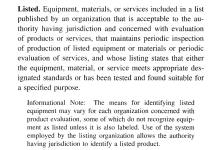
Attachments
Darin
Well-known member
- May 29, 2015
- 398
- Pool Size
- 35000
- Surface
- Vinyl
- Chlorine
- Salt Water Generator
- SWG Type
- CircuPool RJ-60 Plus
What can and cannot be done by a homeowner is determined by the local authority having jurisdiction.
Your city or county building department will specify which projects require a building permit and inspection and which work you can and cannot do as a homeowner.
For example:
POOL BONDING INSPECTION: These inspections are made in reference to swimming pool construction to show that the bonding connections are Code Compliant and installed per Approved Stamped Construction Documents.
POOL FINAL INSPECTION: This inspection is to allow for the inspector to verify that all pool construction is Code Compliant and installed per the Approved Stamped Construction Documents after completion of the pool. All fences, gates, latches, alarms installed, and the pool shall be full of water prior to this inspection.
Can a homeowner obtain permits?
Homeowners may obtain permits to do work on their own residence except mechanical and gas installations.
For the homeowner to do electrical work (maintenance only, not new construction) on their residence (totaling less than $250), an electrical permit must be issued.
For work totaling more than $250, the homeowner must contract with a State of South Carolina licensed electrician.
2.What types of permits are required?
Building Permits
Building or repair of structures
Building of detached structures
Garages and carports
Storage buildings
Fences (most require approval only by Planning Department)
Signs
Construction trailers
Swimming pools
Roofing
 fortmillsc.gov
fortmillsc.gov
Your city or county building department will specify which projects require a building permit and inspection and which work you can and cannot do as a homeowner.
For example:
POOL BONDING INSPECTION: These inspections are made in reference to swimming pool construction to show that the bonding connections are Code Compliant and installed per Approved Stamped Construction Documents.
POOL FINAL INSPECTION: This inspection is to allow for the inspector to verify that all pool construction is Code Compliant and installed per the Approved Stamped Construction Documents after completion of the pool. All fences, gates, latches, alarms installed, and the pool shall be full of water prior to this inspection.
Can a homeowner obtain permits?
Homeowners may obtain permits to do work on their own residence except mechanical and gas installations.
For the homeowner to do electrical work (maintenance only, not new construction) on their residence (totaling less than $250), an electrical permit must be issued.
For work totaling more than $250, the homeowner must contract with a State of South Carolina licensed electrician.
2.What types of permits are required?
Building Permits
Building or repair of structures
Building of detached structures
Garages and carports
Storage buildings
Fences (most require approval only by Planning Department)
Signs
Construction trailers
Swimming pools
Roofing
FAQs • Can a homeowner obtain permits?
If something is a requirement, the word "shall" or "must" will be used.
Shall is an imperative command, usually indicating that certain actions are mandatory, and not permissive.
The word "should" means that something is recommended, but not mandatory.



 www.law.cornell.edu
www.law.cornell.edu
Shall is an imperative command, usually indicating that certain actions are mandatory, and not permissive.
The word "should" means that something is recommended, but not mandatory.

plainlanguage.gov | Shall and must
Plain language makes it easier for the public to read, understand, and use government communications.
www.plainlanguage.gov

plainlanguage.gov | Use “must” to indicate requirements
Plain language makes it easier for the public to read, understand, and use government communications.
www.plainlanguage.gov

shall
phonedave
Well-known member
- May 30, 2012
- 1,962
- Pool Size
- 17000
- Surface
- Vinyl
- Chlorine
- Salt Water Generator
- SWG Type
- Hayward Turbo Cell (T-CELL-5)
As an OSHA Nationally Recognized Testing Laboratory (NRTL) in the U.S., Intertek is also an acceptable certification.
I have worked with Intertek a lot in the past, for NEBS compliance testing.


